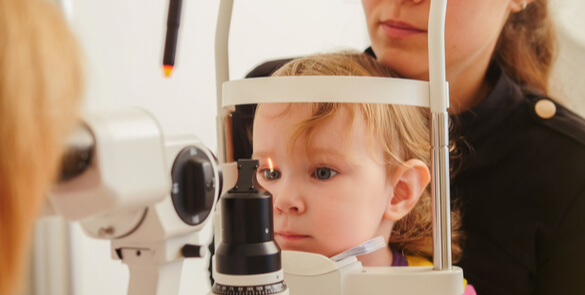Nov 18, 2020

Top 10 Eye Conditions Affecting Children
This blog has been contributed Dr. Alaa Bou Ghannam , Specialist in Neuro-Ophthalmology, Paediatric Ophthalmology & Glaucoma, and Adult Strabismus
Children have their own set of eye diseases that are at times different from what we see among adults. Below is a list of ten of the most common pediatric eye problems seen in a paediatric ophthalmologist’s clinic.
- Refractive errors: This is by far the most common paediatric eye condition. Usually, it is easily treated with glasses. It can be myopia, hyperopia or astigmatism. Children sometimes cannot verbalize their inability to see, so they might squint, blink, turn their heads or just give up on seeing all together which might affect their school performance.
- Strabismus: This happens when the eyes are not aligned together, with one or both eyes drifting or crossing. This can be congenital or acquired; it is usually treated with glasses or surgery. In some cases we can just observe but sometimes systemic workup is needed to rule out underlying conditions.
- Viral conjunctivitis: Eyes are red, watery and have purulent discharge. Typically, it involves one eye and then spreads to the other. Observation is usually the rule as most will resolve uneventfully within 4-10 days. It is highly contagious.
- Allergic conjunctivitis: Presents with itching, blinking, red and watery eyes. Typically involves both eyes simultaneously. It can be seasonal or related to a specific allergen. Severe condition is called vernal catarrh. Treatments include lubrication, antihistamine drops, steroids or cyclosporine drops in severe conditions.
- Amblyopia/ lazy eye: It happens when the brain favors one eye over the other, causing further decrease in vision in the weaker eye. This might be caused by a difference in refractive error between the two eyes, strabismus, or media opacification preventing clear images from reaching the retina. It must be treated early on with patching of the stronger eye or with atropine drops.
- Nasolacrimal duct obstruction: It is usually congenital. Infants have excessive tearing and discharge, treated with nasal massage to open up the nasolacrimal duct. Most resolve by the age of one.
- Chalazion/ stye: It is a benign growth on the eyelid caused by a blockage of the meibomian gland due to lid inflammation. Treatment is usually through lid massage. In most cases it resolves uneventfully. Sometimes, it gets infected and will need antibiotics. If it does not resolve in a month then incision and drainage is recommended.
- Congenital cataract: Infants are born with unilateral or bilateral opacification of the lens. Parents will see a white reflex in the pupils. It is recommended to remove the lens early on to prevent amblyopia.
- Congenital glaucoma: A condition where the pressure in the eye is elevated. Infants with glaucoma will have large eyes (buphthalmous) with tearing and light sensitivity. Surgery is the treatment of choice as drops might not be helpful.
- Retinoblastoma: It is a malignant cancer of the retina. Parents will notice a white reflex in the pupil. It needs urgent diagnosis and treatment that includes chemotherapy, laser therapy and/ or removal of the eyeball (enucleation).
Annual comprehensive eye examinations are recommended for all young children, as many eye conditions may be managed or treated more effectively with early screening and detection.